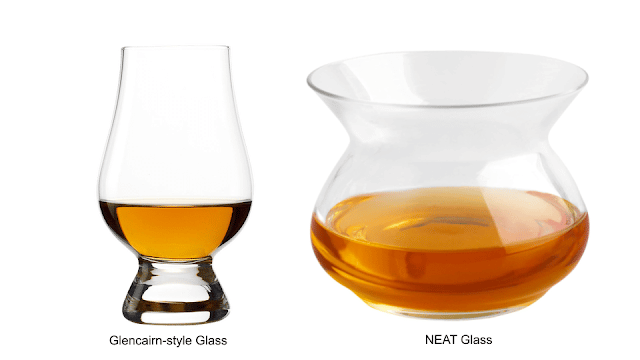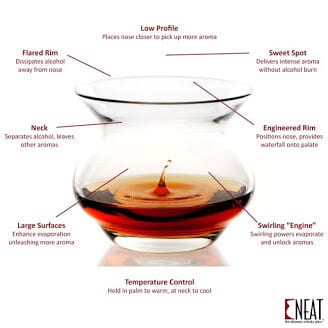Taste & Compare: NEAT and Glencairn | A Hoke Harden Review
With my insistence on “Taste & Compare” I often look for reasons to do just that. So I conducted my semi-scientific controlled spirit tasting comparing the NEAT and Glencairn-design glasses.
At the level of professional tasters and dedicated amateur enthusiasts, two glasses stand out. Each has merits, each has adherents. So it’s natural to compare the two.
Recently, I did a tasting of five Chateau Garreau Bas Armagnacs, in part to review each type, and in part to gain a perspective on the prevailing house style. I felt this type of tasting deserved a professional approach so I used the NEAT glass.
It was the right choice.


then I wondered how much difference I would perceive from the same spirits in a Glencairn-style tasting glass.
So I found out. I nosed and tasted through the Chateau Garreau Bas Armagnacs, then a Hine Rare Cognac, and finally my go-to house whiskey, Old Forester Signature 100 Proof Kentucky Straight Bourbon.
The results? In every taste, the NEAT glass delivered a better experience for me than the Glencairn.
The Glencairn and the NEAT both have dedicated fans. The Glencairn was first and was first favored for Scotch Whisky, then became popular for other whiskeys, and then all sorts of spirits.
I’ve long been fond of the Glencairn for its ability to focus the aromas in such an intense way, to display the core of the aromatic experience of the spirit. “Nothing hides in a Glencairn.” is a standard saying, and for good reason. That ability to expose was also a problem, however. In a brash, brawny spirit raw power can overcome, even obliterate, the more delicate nuances.
The Glencairn is unforgiving. It’s more about force than finesse. It will reveal the charms of a spirit, but it will just as readily exaggerate certain aspects that can make the spirit unpleasant.
The Glencairn is essentially a small, short, glass shaped a little like a glass cannon designed to collect all the aromatic components and volatize them out of the glass up into the nose of the taster. Sounds brutal….and it can be just that if you’re nosing a high-proof spirit, because the alcohol (ethanol) is also conveyed in this ‘shot’ of spirit, and ethanol can carry a mean burn.
our nose naturally hits that zone so you sense the subtlety of different aromatic impressions which you would not be able to distinguish as clearly within an intense volatile blast.
And here is why: the NEAT glass concentrates the aromatics and alcohol in the bowl, providing a wider, larger surface for releasing the aromas. When they volatize up through the ‘pinched’ waist of the glass the aromatics continue up to that ‘sweet spot’ but most alcohols flow up the sides of the glass to the flared rim and dissipate.
Essentially, with that separation, you receive the aromatics in the zone—the sweet spot—with the lessened impact of the alcohol, which gives you the ability to appreciate all those lovely aromatics you probably paid good money for.

Some people are more impressed with power, intensity, and force; some look for subtlety, complexity, and layers of aroma as their ideal.
If you are in the first group, you’ll likely prefer the Glencairn, which is fine. Some like the brash, bold, ‘in your face’ peat smoke and iodine of an Islay Single Malt. The Glencairn glass will deliver all those aromas—and ethanol—in one focused sniff.
If you’re more like the second group, you’re probably going to go for the NEAT glass. The NEAT glass focuses on the aromatic components while moving the ethanol burn out of the spotlight, as is the case with Hine Rare. The Glencairn sends the ethanol up in force; the NEAT shunts the ethanol gently to the rim and away.
After my casual taste and compare trial, it was clear I preferred the NEAT glass. It provided exposure to all the components and increased my perception of the complexity of the spirit. The Glencairn seemed to punch the spirit into your nose—and in a high alcohol spirit that can stun your nasal passages with anosmia (briefly losing some of your sense of smell).
[Perspective: We constant nosers and sippers tend to get comfortable—or perhaps acclimated is a better word—to high-proof spirits. We also tend to forget inexperienced tasters haven’t developed that familiarity. I might be waxing poetically about my lovely, gentle, balanced spirit, while the row of students are looking at me blankly. I’m enjoying ephemeral spirits; their eyes are tearing because the ethanol just singed their nose hairs. The NEAT attenuates that burn.]
Example 1: Chateau Garreau Bas Armagnac Folle Blanche. This was an experimental spirit, a young Folle Blanche with short-term oak aging to emphasize the primary floral qualities of the grape variety. It was bottled at cask strength. The lovely but delicate fruit/floral expression of the Folle Blanche was shoved out of balance by the ethanol in the Glencairn glass. The NEAT glass shunted away just enough of the ethanol to allow the complexities of the Folle Blanche to emerge
Example 2: Hine Rare Cognac. The Hine is a beautifully constructed blend of different cognacs that contain some older examples, and those hints of extended age and richness are essential to the style of Hine. Again, the Glencairn made the Hine seem heavier and coarser in the nose, while the NEAT allowed those enticing, subtle aromas to separate from the alcohol and float right up to the sweet spot.
Example 3: Old Forester Signature 100 Proof Kentucky Straight Bourbon. This is my go-to house Bourbon. Reliable, consistent, and dependable, the Old Forester nose came through fine from the Glencairn. But the NEAT edged it out just that little bit to soften and warm and expand the wood-aged notes and the lovely rich caramel that characterizes Old Forester.
I’ll add that for all its attributes the NEAT glass is not what I would call a drinking glass. It is a nosing glass/tasting glass, designed for that specific purpose. So, when you come to my house you’ll get your Old Forester Signature 100 Old Fashioned in an Old-Fashioned Glass and your Woodford Reserve Double Oaked Manhattan in a martini glass. But both will have been tasted in a NEAT glass before preparing the cocktail.
NEAT and Arsilica (“Changing the Way the World Drinks”) are now one company. Arsilica plans to bring forth new designs to expand its glass portfolio. Sensation Research did an Independent study.

